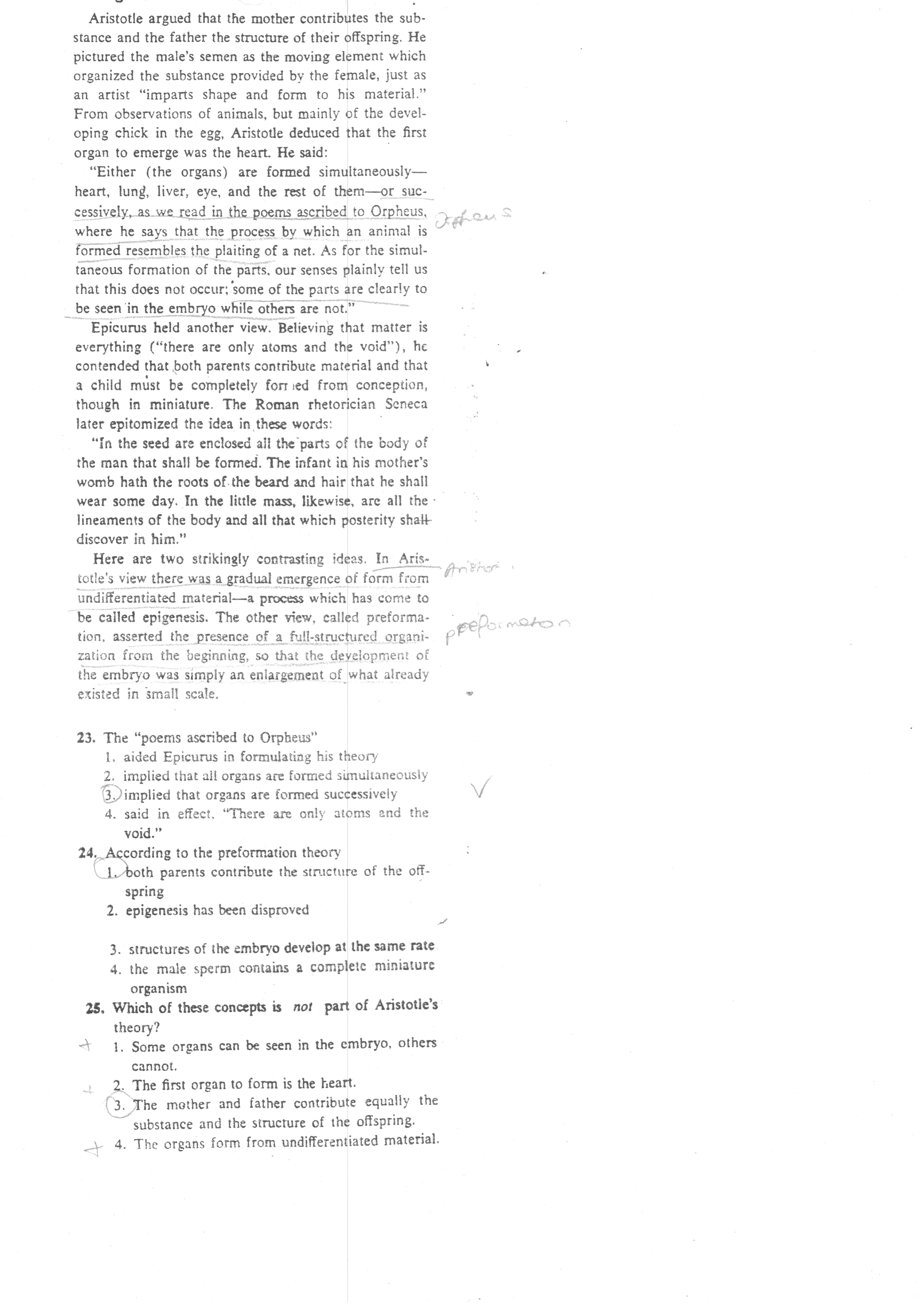czytanie teksty (8)

Aristotle argued that the mother contributes the sub-stance and the father the structure of their offspring. He pictured the male’s semen as the moving element which organized the substance provided by the female, just as an artist “imparts shape and form to his materiał.” Prom observations of animals, but mainly of the devel-oping chick in the egg, Aristotle deduced that the first organ to emerge was the heart. He said:
“Either (the organs) are formed simultaneously— heart, lung, Iiver, eye, and the rest of them—orsuc-cessiygly^JEK-Wfijęgad m the poems ascribed to Orpheus, where he says that the process by which an animal is formed resembies the plaiting of a net. As for the simul-taneous formation of the parts, our senses plainly tell us that this does not occur; some of the parts are clearly to be seen in the embryo while others are not.”
Epicurus held another view. Believing that matter is everything (“there are only atoms and the void”), he contended that both parents contribute materiał and that a child must be completely fon *ed from concepiion, though in miniaturę. The Roman rhetorician Scneca later epitomized the idea in these words:
MIn the seed are enclosed al! the parts of the body of the man that shall be formed. The infant in his mothefs womb hath the roots of the beard and hair that he shail wear some day. In the little mass, likewise, are all the lineaments of the body and all that which posterity shaiP discover in him.”
Here are two strikingly contrasting ideas. In Aris-totle’s view there was a graduał emergence of form from undifferentiated materiał—a process which has come to be called epigenesis, The other view, called pceforma-tion, asserted the presence of a Pił!-struć tu red organi-zatioa from the beginniog, so that the deyelppment of the embryo was simply an enlargement of what already eristed in smal! scalę.
23. The “poems ascribed to Orpheus”
1. aided Epicurus in formulating his theory
V
2. i nip l ied that all organs are formed simuitaneousły
3. implied that organs are formed successively
4. said in effect, łThere are only atoms and the void.”
24^Aęcording to the preformation theory
vJL^>oth parents contribute the structure of the otf-spring
2. epigenesis has been disprowl
3. structures ot the embryo develop at the same ratę
4. the małe sperm contains a complete miniaturę organ ism
25, Which of these concepts is not part of Aristotle’s
theory?
A" 1. Some organs can be seen in the embryo, others cannot.
The first organ to form is the heart.
3. The mother and father contribute equal!y the substance and the structure of the offspring.
4. The organs form from undifferentiated materiał.
Wyszukiwarka
Podobne podstrony:
czytanie teksty (7) Stephen Leacock “Softening the Stones for Children” What is the major propositio
2. The World of Atoms 2.1. The structure of the atom For many centuries people believed that matter
PROGRAM ROZWOJOWY^1 POLITECHNIKI WARSZAWSKIEJ It should be noticed that the interval of conduction i
Testing indicates that the proportion of people who have had COVID-19 in the U.K. is Iow, but that t
PROGRAM ROZWOJOWY^1 POLITECHNIKI WARSZAWSKIEJ It should be noticed that the interval of conduction i
11 11 2 T topie explain that the topie of the speech is is important to the audience.
Effect Of Dividends On Slock Prices 7 that can be in accordance with the expectations of their share
88 A. Wawrzak, K. Karwowski, K. Karwowski, S. Mandra, M. Mizan Assuming that the bandwidth of veloci
42 Toman Pajor /W Btonomk Ltns. Polish report 43 II. If one assumes that the cmplo
722 KONSrUANTSNOS HATZOFOtPUlJOS 2 In connection with this notę, -we jEirst presnmed that the r
6 The extensive character of this economy is accounted for by the fact that the ąuality of water sta
72 S. Źróbek, R. Cellmer, J. Kuryj In the analyses, it was also taken into account that the use of m
30 Paweł Mąkosa research performed, it has been determined that the level of digitization of educati
więcej podobnych podstron